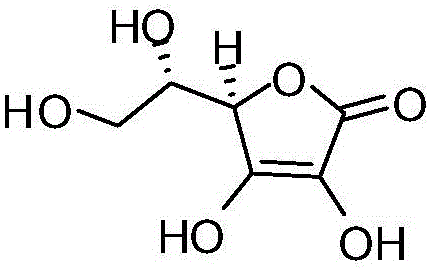Method for detecting dehydrogenized vitamin C in vitamin C
A vitamin and dehydrogenation technology, applied in the direction of measuring devices, instruments, scientific instruments, etc., can solve the problems of low sensitivity, low sensitivity, loss of vitamin C, etc., and achieve the effect of good repeatability and high sensitivity
- Summary
- Abstract
- Description
- Claims
- Application Information
AI Technical Summary
Problems solved by technology
Method used
Image
Examples
Embodiment 1
[0036] The detection of embodiment 1 limit of detection and limit of quantitation
[0037] Step (1), accurately weigh 19.91 mg of the dehydrogenated VC reference substance (95.0%), put it in a 25ml measuring bottle, add mobile phase B to dissolve and dilute to the mark, and shake well;
[0038] Step (2), accurately measure 1ml of the solution in step (1), put it in a 100ml measuring bottle, add mobile phase B to dilute to the mark, and shake well;
[0039] Step (3), accurately measure 5ml of the solution in step (2), put it in a 100ml measuring bottle, add mobile phase B to dilute to the mark, shake well, and use it as the solution to be tested;
[0040] In step (4), 20 μl is accurately measured and injected into a liquid chromatograph, the signal-to-noise ratio S / N=10:1, and the solution is used as the quantification limit solution, and the quantification limit concentration is 0.38 μg / ml;
[0041] Step (5), accurately measure 3ml of the limit of quantitation solution, put i...
Embodiment 2
[0042] The determination of embodiment 2 standard curve
[0043] Step (1), accurately weigh 40.90 mg of the dehydrogenated VC reference substance (95.0%), put it in a 50ml measuring bottle, add mobile phase B to dissolve and dilute to the mark, shake well, and use it as the reference substance stock solution;
[0044] Step (2), accurately measure 2.5ml, 4ml, 5ml, 6ml, 7.5ml, and 10ml of the solution in step (1), put them in 100ml measuring bottles, add mobile phase B to dilute to the mark, shake well, and use them as linear Solution 1, linear solution 2, linear solution 3, linear solution 4, linear solution 5, linear solution 6;
[0045] Step (3) Accurately measure 20 μl each of the linear solutions 1-6 in step (2), inject into the liquid chromatograph, including the limit of quantification, take the concentration as the abscissa, and the peak area as the ordinate, perform linear regression, linear The equation is A=4.3953C-2.9546, the unit of C is ug / ml, A is the peak area; ...
Embodiment 3
[0046] Embodiment 3 Dehydrogenated VC recovery rate is measured
[0047] Step (1), weigh about 0.4g of VC raw material, put it in a 10ml measuring bottle, add mobile phase B to dissolve and dilute to the mark, shake well, and use it as the solution to be tested; accurately weigh the dehydrogenated VC reference substance (with a content of 95.0 %) 11.63mg, put in a 25ml measuring bottle, add mobile phase B to dissolve and dilute to the mark, shake well, as the reference substance stock solution, accurately measure 1ml, put in a 10ml measuring bottle, add mobile phase B to dilute to the mark, shake Uniform, as the reference substance solution;
[0048] Step (2): Accurately weigh three parts of about 0.4g of VC raw material, put each in a 10ml measuring bottle, add 0.8ml, 1.0ml, and 1.2ml of the reference substance stock solution respectively, dissolve and dilute to the mark with mobile phase B, shake Evenly, as 80%, 100%, and 120% group test solution respectively, each concentr...
PUM
| Property | Measurement | Unit |
|---|---|---|
| wavelength | aaaaa | aaaaa |
| wavelength | aaaaa | aaaaa |
Abstract
Description
Claims
Application Information
 Login to View More
Login to View More - R&D
- Intellectual Property
- Life Sciences
- Materials
- Tech Scout
- Unparalleled Data Quality
- Higher Quality Content
- 60% Fewer Hallucinations
Browse by: Latest US Patents, China's latest patents, Technical Efficacy Thesaurus, Application Domain, Technology Topic, Popular Technical Reports.
© 2025 PatSnap. All rights reserved.Legal|Privacy policy|Modern Slavery Act Transparency Statement|Sitemap|About US| Contact US: help@patsnap.com



